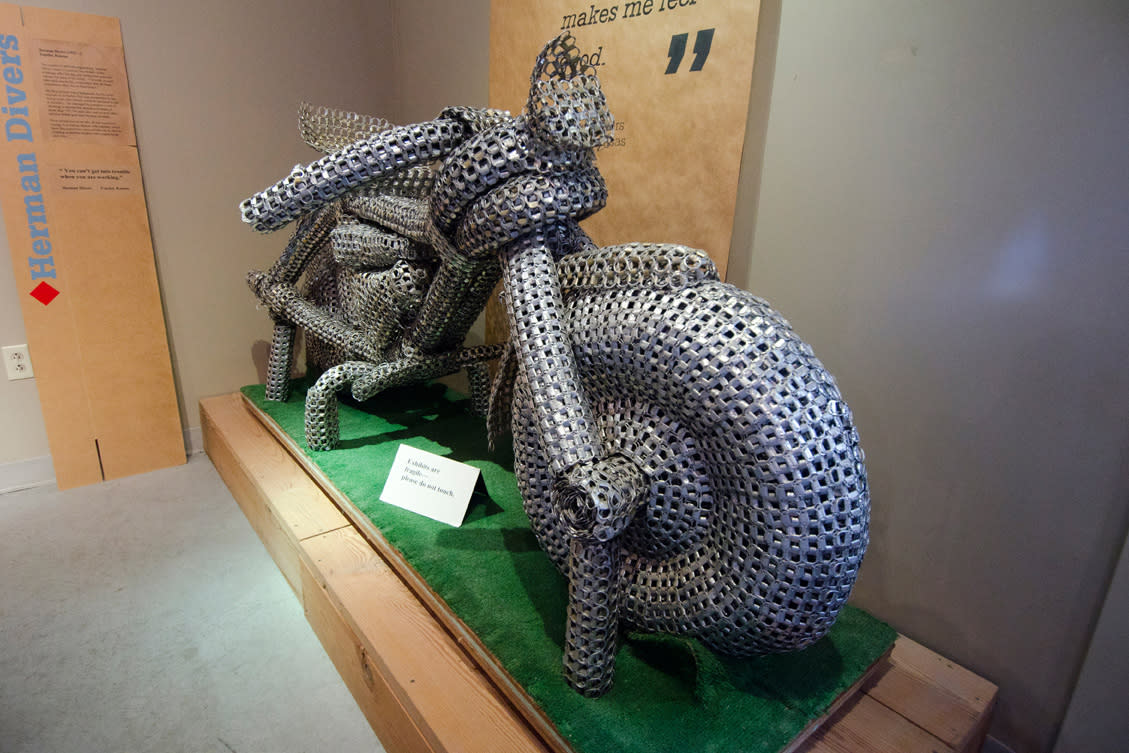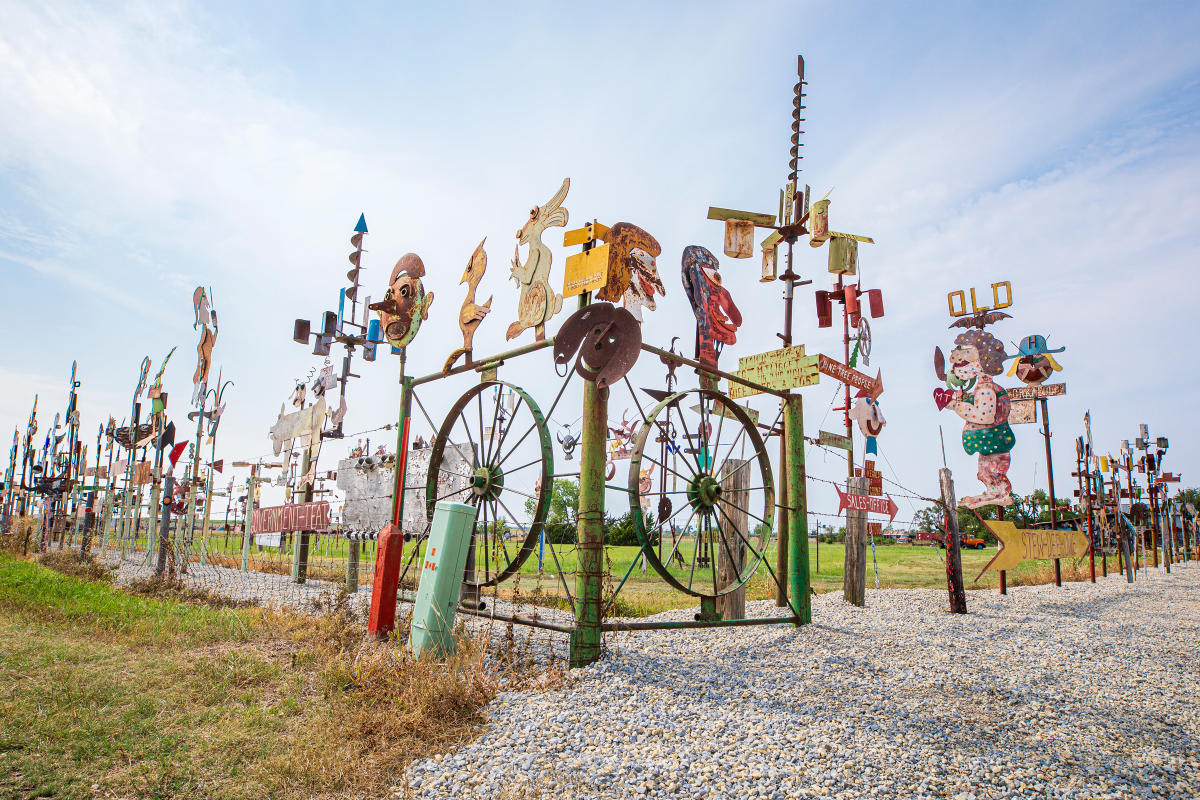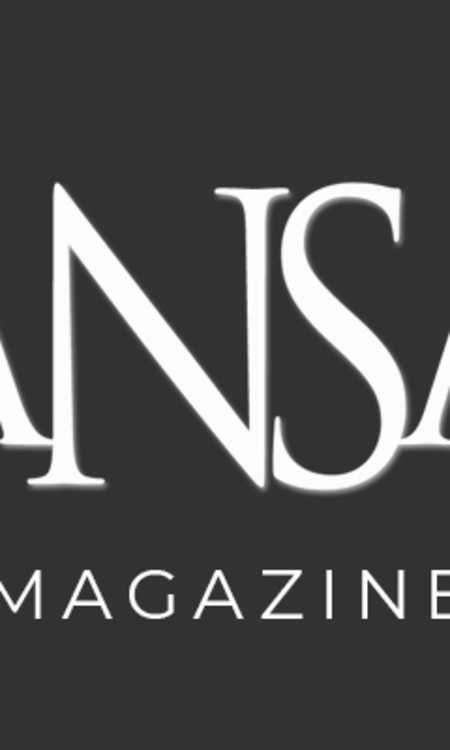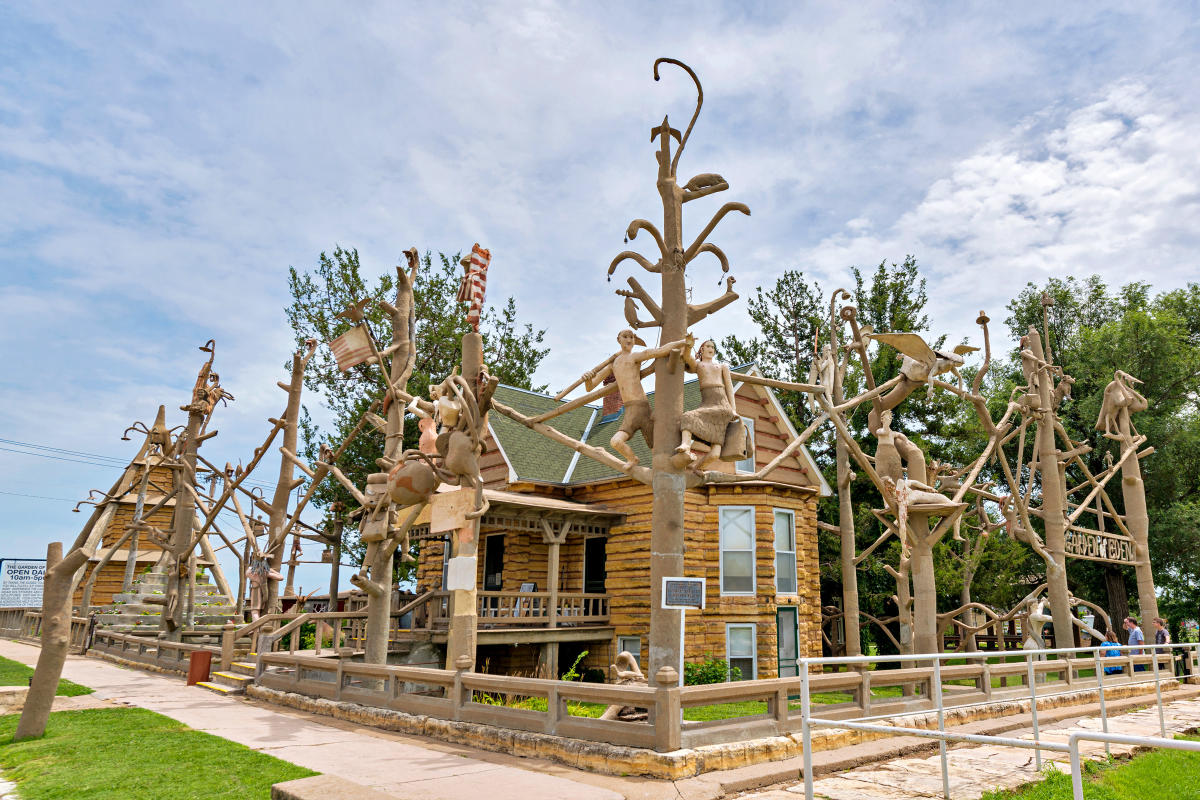Discover mechanical marvels and whimsical creatures in this Midwestern capital for folkart
Kansas has long been a surprising haven for visionary folk artists who transform everyday materials into bold, often bizarre, artistic statements. From the fantastical Garden of Eden in Lucas to a dinosaur park made of car parts, this journey through Kansas’ grassroots art sites reveals a state brimming with creative energy and offbeat charm. Hop in the car and uncover the curious corners of Kansas where imagination runs wild.
Garden of Eden
Lucas
Add Lucas to your must-see destinations, for the Garden of Eden is sure to please. This jaw-dropper is the oldest complete folk art environment in the United States, creating an imaginative epicenter in this rural town. Civil War veteran, populist and artist Samuel P. Dinsmoor began pouring forth his vision in 1907 when, at age 64, he completed his log cabin home built from native limestone. Then, using the newest building compound—concrete—he spent the next 18 years surrounding his house with a narrative sculpture garden.
Serpents, soldiers, Adam and Eve are all on display, enduring harsh Midwestern weather. Dinsmoor himself lays on display in a mausoleum out back. Populists believed that humor could help get people’s attention, and the sheer audacity of the Garden has brought plenty of grins.
The garden was also the first place in Lucas to have its own electric generator powering lights. The night train, which ran from Kansas City to Denver, would stop once it saw the glow on the horizon, letting passengers off to marvel at the site and get a good dose of Kansas populist preaching.
As one might suspect, the community hasn’t always been crazy about the Garden. At one point, there was serious talk of bulldozing the Garden down. Luckily, cooler heads prevailed. And just last summer, the fine folks from Kohler (yep, that Kohler) came down and restored the Garden to Dinsmoor’s vision.

Grassroots Art Center
Lucas
Visitors entering Lucas are greeted by a sign created in the spirit of Kansas folk artist and farmer Ed Root. In 1937 an automobile accident ended his farming career in the Saline River Valley. He then began to build hundreds of cast-concrete pieces studded with broken
glass, rocks, toys and jewelry.
The Kansas Grassroots Art Association and Art Center has it all, and curator Rosslyn Schultz has celebrated Kansas folk art. Here visitors will find works by many Kansas artists, including Root, Leroy Wilson, Inez Marshall, John Woods, Lawrence Reynolds, Earl Slagle, Glenn Stark and the chewing gum art of Betty Milliken.
Spearmint was the medium of choice for Milliken, who created the likeness of friends out of chewing gum. Caulk, talcum powder, orange peels, Styrofoam meat trays ... all possessed portrait possibilities for the Lawrence native.
Inez Marshall’s collection includes large (and heavy) limestone pieces. At her Continental Sculpture Hall in Portis, she carved houses, cars and stone guitars.
But best of all is Herman Divers’ pull-tab motorcycle and car. Built in Topeka, Drivers used nothing but the little metal rings pulled from pop and beer cans, 35 years or older, in days of yore. Herman knew he could use them to make things, like a hat, vest, slacks, an umbrella, chair and table. “I don’t know how I knew, I just did,” he says.
The full-size motorcycle, with wheels that actually roll, is the pull-tab piece de resistance made with an astonishing 179,200 pull-tabs. The Topeka native started small with a bedspread and some clothing. Since pull-tab cans are no longer an available resource, he has turned his talents to creating objects with threaded buttons.

MT Liggett Art Environment
Mullinville
It all began with a gargoyle to protect M.T. Liggett’s horse. What came next was a less-than flattering caricature of a county commissioner. Soon, Liggett’s welded social commentary took root on his farm just outside Mullinville.
In 1989, after a career in the Air Force, Liggett returned to the farm where he grew up. There he began creating fantastic, sometime kinetic, “totem poles” from scraps of metal, old car parts, road signs and just about anything else he could find. Now stretching almost a mile along Route 400, his garden of goat-getting political satire keeps the town folks at the local diner buzzing.
“I say what I want to say,” quips Liggett. But beneath his gruff exterior lied an extremely intelligent and talented artist who just had a lot to say. Littgett passed away in 2017, but the site he created continues to attract visitors. Travelers can learn more about Liggett at the visitor center. Taking in the football-field-sized outdoor gallery is a memorable stop that shouldn’t be missed.
Robert Dorris’ Dinosaur Not-So-Natural Park
Erie
This former Air Force engineer began to populate his yard with “half-assic” creatures after he retired. The giant reptiles and dinosaurs are rigged from car parts skillfully welded together (with some attempt at structural accuracy gathered at the Museum of Natural History in Washington, D.C.) This attraction will delight small, and rather large, children.
Robert died in 2007 at the age of 82; however, his son is still taking care of the property and dinosaurs. It’s an awe-inspiring site to see what one man can do with a welding torch, scrap parts and an old pickup with a crane.





